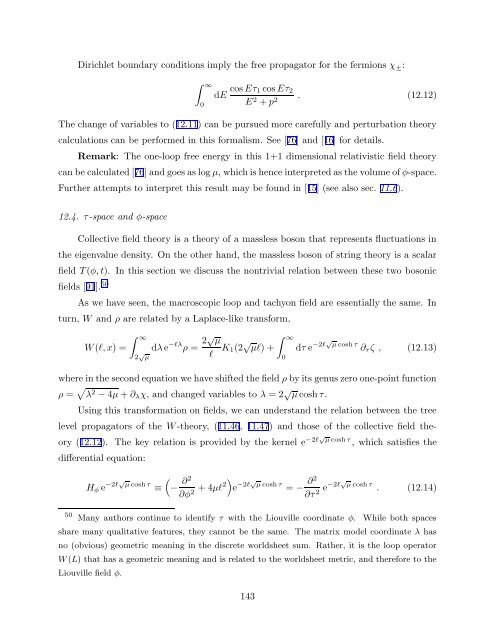arXiv:hep-th/9304011 v1 Apr 5 1993
arXiv:hep-th/9304011 v1 Apr 5 1993
arXiv:hep-th/9304011 v1 Apr 5 1993
You also want an ePaper? Increase the reach of your titles
YUMPU automatically turns print PDFs into web optimized ePapers that Google loves.
Dirichlet boundary conditions imply <strong>th</strong>e free propagator for <strong>th</strong>e fermions χ ± :<br />
∫ ∞<br />
0<br />
dE cos Eτ 1 cos Eτ 2<br />
E 2 + p 2 . (12.12)<br />
The change of variables to (12.11) can be pursued more carefully and perturbation <strong>th</strong>eory<br />
calculations can be performed in <strong>th</strong>is formalism. See [76] and [16] for details.<br />
Remark: The one-loop free energy in <strong>th</strong>is 1+1 dimensional relativistic field <strong>th</strong>eory<br />
can be calculated [76] and goes as log µ, which is hence interpreted as <strong>th</strong>e volume of φ-space.<br />
Fur<strong>th</strong>er attempts to interpret <strong>th</strong>is result may be found in [15] (see also sec. 11.6).<br />
12.4. τ-space and φ-space<br />
Collective field <strong>th</strong>eory is a <strong>th</strong>eory of a massless boson <strong>th</strong>at represents fluctuations in<br />
<strong>th</strong>e eigenvalue density. On <strong>th</strong>e o<strong>th</strong>er hand, <strong>th</strong>e massless boson of string <strong>th</strong>eory is a scalar<br />
field T (φ, t). In <strong>th</strong>is section we discuss <strong>th</strong>e nontrivial relation between <strong>th</strong>ese two bosonic<br />
fields [91]. 50<br />
As we have seen, <strong>th</strong>e macroscopic loop and tachyon field are essentially <strong>th</strong>e same. In<br />
turn, W and ρ are related by a Laplace-like transform,<br />
W (l, x) =<br />
∫ ∞<br />
2 √ µ<br />
dλ e −lλ ρ = 2√ µ<br />
K 1 (2 √ ∫ ∞<br />
µl) + dτ e −2l√ µ cosh τ ∂ τ ζ , (12.13)<br />
l<br />
0<br />
where in <strong>th</strong>e second equation we have shifted <strong>th</strong>e field ρ by its genus zero one-point function<br />
ρ = √ λ 2 − 4µ + ∂ λ χ, and changed variables to λ = 2 √ µ cosh τ.<br />
Using <strong>th</strong>is transformation on fields, we can understand <strong>th</strong>e relation between <strong>th</strong>e tree<br />
level propagators of <strong>th</strong>e W -<strong>th</strong>eory, (11.46, 11.47) and <strong>th</strong>ose of <strong>th</strong>e collective field <strong>th</strong>eory<br />
(12.12). The key relation is provided by <strong>th</strong>e kernel e −2l√ µ cosh τ , which satisfies <strong>th</strong>e<br />
differential equation:<br />
H φ e −2l√ µ cosh τ ≡<br />
(− ∂2<br />
∂φ 2 + 4µl2 )<br />
e −2l√ µ cosh τ = − ∂2<br />
∂τ 2 e−2l√ µ cosh τ . (12.14)<br />
50 Many au<strong>th</strong>ors continue to identify τ wi<strong>th</strong> <strong>th</strong>e Liouville coordinate φ. While bo<strong>th</strong> spaces<br />
share many qualitative features, <strong>th</strong>ey cannot be <strong>th</strong>e same. The matrix model coordinate λ has<br />
no (obvious) geometric meaning in <strong>th</strong>e discrete worldsheet sum. Ra<strong>th</strong>er, it is <strong>th</strong>e loop operator<br />
W (L) <strong>th</strong>at has a geometric meaning and is related to <strong>th</strong>e worldsheet metric, and <strong>th</strong>erefore to <strong>th</strong>e<br />
Liouville field φ.<br />
143
















